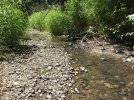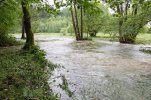Habitat optimisation
Hydrology
Today, freshwater pearl populations in Germany are at risk due to climate change. More frequent and longer-lasting droughts and the partial drying out of entire sections of rivers and streams during summer is severely affecting populations. At the same time, heavy rain events are becoming more frequent and intense and this trend is set to continue in the future. These cause extreme hydrological situations for freshwater pearl mussel stocks. This is made worse by the low water retention capacities of the catchment areas, e.g. as a consequence of extensive drainage of the land via drains. During the winter months, when there is little evaporation, more water from the surrounding area runs into streams which increases the flow. Conversely, no water can be retained in the catchment for the summer months, when there is much more evaporation. Hydrological extremes are exacerbated as a result.
To tackle this problem, as part of the MARA Project measures to increase the water retention capacities of areas that were originally flood plains will be implemented. Ideally this should be done through the large-scale rewetting of the land surrounding the freshwater pearl mussel streams. Furthermore, an emergency plan should be put together for bodies of water that are particularly at risk of drought. In addition to evacuation plans, the emergency plan should also establish a remote warning system and include the use of pond systems as reservoirs. To increase water retention in the catchment, the use of controlled drains and the establishment of an inter-disciplinary drain management plan should be implemented, amongst other things. This should prevent the direct run-off of water from the surrounding area into streams and instead retain it. This would also benefit wetlands and the different species, such as amphibians, that live there. In addition, it would contribute to decentralised flood protection.



